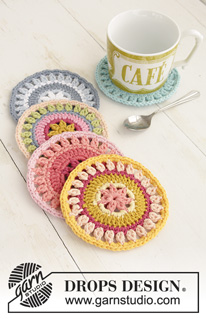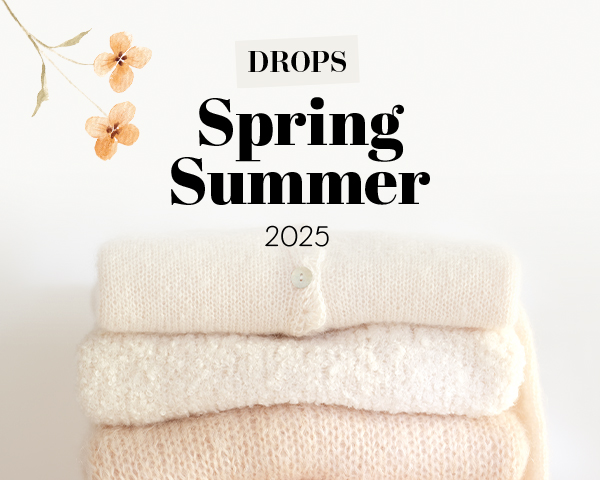Comments / Questions (8)
![]() Claudia wrote:
Claudia wrote:
Habt ihr die Anleitung auch schriftlich? Lg
04.06.2025 - 21:51DROPS Design answered:
Liebe Claudia, es gibt hier nur Diagram, aber auch ein Video ,das Ihnen helfen kann. Viel Spaß beim Häkeln!
05.06.2025 - 09:06
![]() Lynn wrote:
Lynn wrote:
This was a great pattern and I enjoyed making a couple of quick coasters. Thank you.
14.08.2019 - 22:01Sue Mills wrote:
DROPS Design 10.05.2018 kl. 07:57: Coaster 5 on page 3 of printed pattern Rounds 3-4 it states coral. what shade number is coral please
10.05.2018 - 10:45DROPS Design answered:
Dear Sue, the names of each color can be slightly different in the different languages, that may caused the confusion. It is number 38 (which is called rabsberry in English, corall in other languages, it is a lighter, corall-ey shade of red). Happy Crocheting!
10.05.2018 - 11:14Sue Mills wrote:
Coaster 5 on page 3 of printed pattern Rounds 3-4 it states coral. Is this correct??
09.05.2018 - 23:10DROPS Design answered:
Dear Sue, yes it is correct. No 5, row 3-4 is done with the color CORAL. All the translations are done from the Norwegian version, if there is any doubt of colors, sizes, and other numbers, you can always check the original pattern. Happy Crafting!
10.05.2018 - 07:57
![]() Angela wrote:
Angela wrote:
Hallo, ich habe bestimmt die gleiche Frage. Was bedeutet das Zeichen V in der 5. Reihe. In Reihe 4 wird das Muster unterschiedlich gehäkelt ist das Richtig? Liebe grüße aus Hamburg
28.08.2017 - 19:08DROPS Design answered:
Liebe Angela, danke für Ihre Rückmeldung, das V Zeichen in der 5. Reihe ist für 2 fM in die selbe Masche (= Zunahme) - Eine Korrektur kommt sicher gleich. Viel Spaß beim häkeln!
29.08.2017 - 09:00
![]() Lise Nielsen wrote:
Lise Nielsen wrote:
Grethe, jeg har spurgt i web hæklegruppe og fået dette svar 'Ud fra diagrammet ville jeg mene det er 2 fm i samme maske'.
27.08.2017 - 17:46
![]() Lise Nielsen wrote:
Lise Nielsen wrote:
Jeg vil også gerne vide hvad 'v' betyder. Tak
27.08.2017 - 17:30DROPS Design answered:
Hei Lise. Så flott at du fant ut av det selv og delte din kunnskap. Vi vil legge til forklaringen så snart som mulig.
28.08.2017 - 10:15
![]() Grethe wrote:
Grethe wrote:
Diagramforklaring: Symbolet "v" fins i 6 omgang, men kan ikke se at den fins i diagramforklaringen, så hvilken maske skal det være?
24.08.2017 - 21:43DROPS Design answered:
Hei Grethe. Her er det blitt glemt et symbolforklaring. V = "2 fastmasker i samme maske". Det vil bli lagt til en forklaring så snart som mulig. Takk for ta du gjorde oss oppmerksom på dette. God Fornøyelse videre!
28.08.2017 - 10:13
Breakfast Flavours#dropsbreakfastflavours |
|||||||||||||||||||||||||||||||
 |
 |
||||||||||||||||||||||||||||||
Crocheted coasters. Piece is crocheted in DROPS Paris.
DROPS Extra 0-1386 |
|||||||||||||||||||||||||||||||
|
INFORMATION FOR PATTERN: PATTERN: See diagram A.1. COLOR COMBINATION: Coasters are numbered like this: Coaster 1 is on the side of the cup, then count on a line from left towards right. COASTER 1: CAST ON + ROUNDS 1 to 7: Light turquoise COASTER 2: CAST ON + ROUNDS 1 to 2: White ROUND 3: Light wash ROUND 4: Gray blue ROUND 5: White ROUND 6: Light wash ROUND 7: Gray blue COASTER 3: CAST ON + ROUNDS 1 to 2: Mustard ROUND 3: Heather ROUND 4: Medium pink ROUND 5: Gray blue ROUND 6: Pistachio ROUND 7: Peach COASTER 4: CAST ON + ROUNDS 1 to 2: Apricot ROUND 3: Vanilla ROUND 4: Mustard ROUND 5: Heather ROUND 6: Peach ROUND 7: Strong yellow COASTER 5: CAST ON + ROUNDS 1 to 2: Heather ROUNDS 3-4: Coral ROUNDS 5-6: Apricot ROUND 7: Light pink COLOR CHANGE: To get a nice transition between the color changes, work last slip stitch on round with the new color as follows: Insert hook in first chain stitch from beginning of round, make a yarn over with the new color and pull it through stitch on hook. ---------------------------------------------------------- COASTER: Begin on hook size 4 mm / G/6 and work pattern in the round according to diagram A.1 - read COLOR COMBINATION and COLOR CHANGE above. REMEMBER THE CROCHET GAUGE! Coaster measures approx. 12 cm / 4¾" in diameter. Fasten off. |
|||||||||||||||||||||||||||||||
Diagram explanations |
|||||||||||||||||||||||||||||||
|
|||||||||||||||||||||||||||||||

|
|||||||||||||||||||||||||||||||
Have you finished this pattern?Tag your pictures with #dropspattern #dropsbreakfastflavours or submit them to the #dropsfan gallery. Do you need help with this pattern?You'll find 13 tutorial videos, a Comments/Questions area and more by visiting the pattern on garnstudio.com. © 1982-2025 DROPS Design A/S. We reserve all rights. This document, including all its sub-sections, has copyrights. Read more about what you can do with our patterns at the bottom of each pattern on our site. |
|||||||||||||||||||||||||||||||























































Post a comment to pattern DROPS Extra 0-1386
We would love to hear what you have to say about this pattern!
If you want to leave a question, please make sure you select the correct category in the form below, to speed up the answering process. Required fields are marked *.